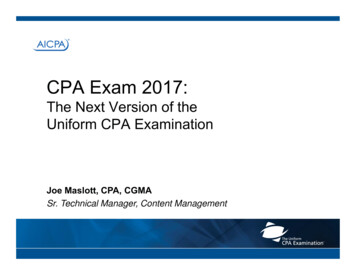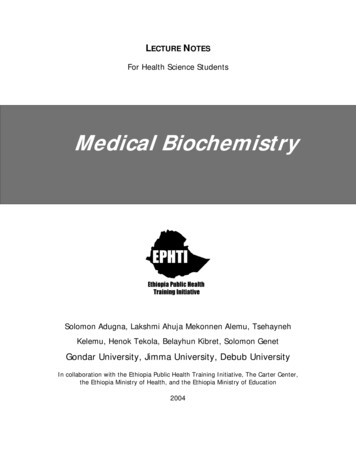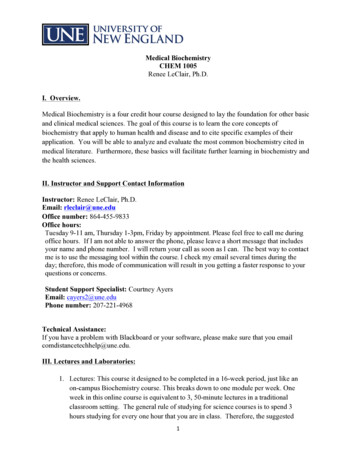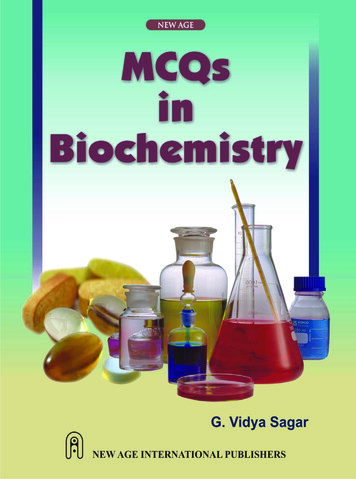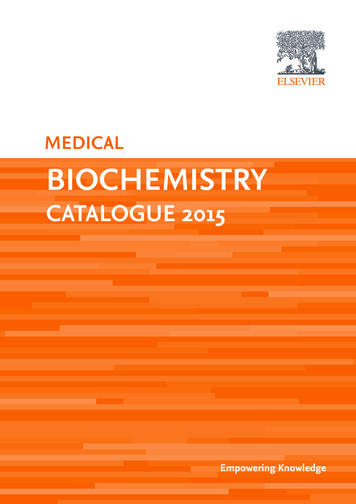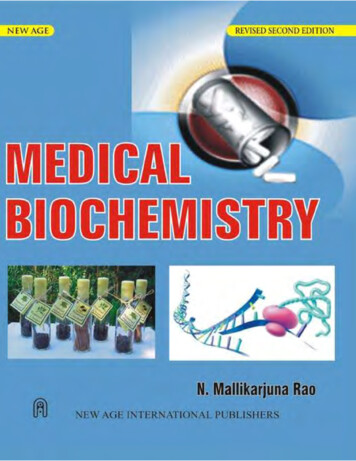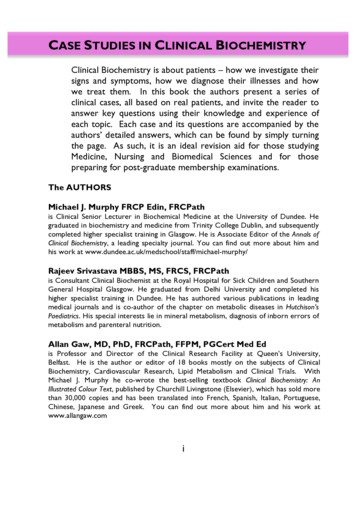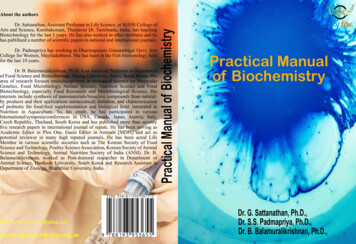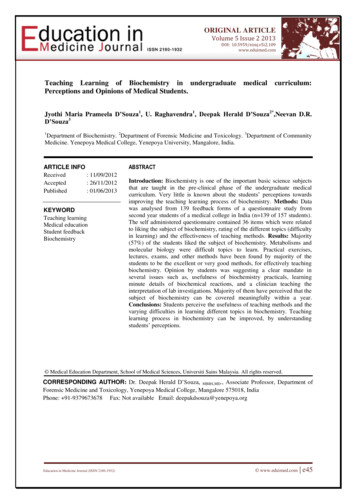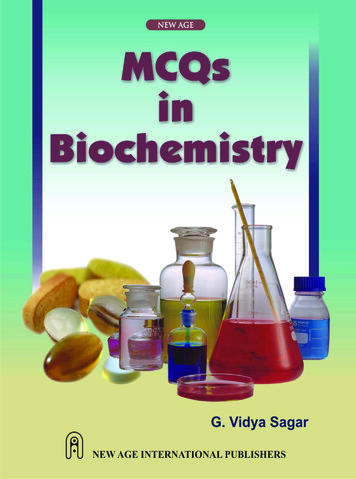
Transcription
This pageintentionally leftblank
Copyright 2008, New Age International (P) Ltd., PublishersPublished by New Age International (P) Ltd., PublishersAll rights reserved.No part of this ebook may be reproduced in any form, by photostat, microfilm,xerography, or any other means, or incorporated into any information retrievalsystem, electronic or mechanical, without the written permission of the publisher.All inquiries should be emailed to rights@newagepublishers.comISBN (13) : 978-81-224-2627-4PUBLISHING FOR ONE WORLDNEW AGE INTERNATIONAL (P) LIMITED, PUBLISHERS4835/24, Ansari Road, Daryaganj, New Delhi - 110002Visit us at www.newagepublishers.com
Dedicated toPROF. DR. F.V. MANVISecretaryKLE Society, BELGAUMKARNATAKA.“To My First Pharmacy teacher with Love”
This pageintentionally leftblank
FOREWORDCompetitive Examinations are the order of the day. All Colleges conducting professional courses at PG level areadmitting students based on common entrance examination, which is of objective type.In Pharmacy, M.Pharm admissions are based on qualifying the GATE enterance examination conducted by Govt.of India.In this book, The author has done good work in preparing several objective questions which help the students to facethe subject in the examination with poise and confidence.The book is well balanced and consists of multiple choice questions from all the important topics like carbohydratemetabolism and other important Biochemical aspects.The typesetting and quality of printing is good. The author is also well experienced in taking up this type of work.I recommend this book to all the students preparing for GATE examination and also for Medical and PharmacyCollege libraries.PROF. B.G. SHIVANANDAPrincipalAL-AMEEN COLLEGE OF PHARMACYBANGALORE.
WATER AND ELECTROLYTE BALANCE289PREFACEPREFAI have brought out this book basically for students who plan to appear for Biochemistry in the entrance examinations likeJIPMER and other Medical, Pharmacy, Physiotherapy, Nursing and other Paramedical PG Entrance Examinations. Thereis a dearth of good entrance manual of Biochemistry for the above said examinations. Hence, I have prepared anexhaustive Question bank of around 5000 MCQs with answers covering a wide spectrum of basic Biochemical topics ofthe subject.Some of the important topics which are given a good coverage include Carbohydrate metabolism, Protein metabolism, Lipid metabolism, Nucleic acids, Enzymes, Vitamins and Mineral metabolism.The objective questions are prepared based on the background taken from previous question papers of Professional medical and Paramedical competitive entrance examinations.The book serves as a ready reckoner for Biochemistry as far as objective pattern is concerned. I feel satisfied if thebook serves the purpose for which it is intended.I have tried to minimize typographical errors but still some must have crept in. If they are brought to my notice, I willbe rectifying them in the next edition.Constructive Criticism is always welcomeG. Vidya Sagar
ACKNOWLEDGEMENTSI wish to express my profound gratitude and benevolence to the following who were the inspiring force in making thisbook a reality Prof. Dr. Kishor Pramod Bhusari Sadhvi ShilapijiPrincipal, Nagpur College of PharmacyChair person, Veerayatan Vidyapeeth,Nagpur.Jakhaniya, Kutch, Gujarat Prof. Dr. R. Rangari Prof. Dr. R.K. GoyalPrincipal, J.N. Chaturvedi College of PharmacyL.M. College of PharmacyNagpurAhmedabad, Gujarat Prof. Dr. Anant Naik Nagappa Prof. Dr. A.K. SalujaPharmacy group, Birla Institute of Technology &A.R. College of PharmacySciencesVallabh VidyanagarPilani, RajasthanGujarat Prof. Dr. Srinivas Rao Prof. J.V.L.N. Sheshagiri RaoPrincipal, VEL’s College of PharmacyDept. of Pharmaceutical SciencesChennaiAndhra University, Vishakhapatnam, A.P.Finally, I express my gratitude to Mr. Saumya Gupta. MD, New Age International (P) Limited, New Delhi, for hisencouragement and support.Dr. G.Vidya Sagar
SOME VALUABLE COMMENTSVALUALUABLEThis book is very useful for students appearing for GATE Exams. Recommended reading.Prof. Dr. Subhas C. MarihalPrincipal, Goa College of Pharmacy, Goa.Biochemistry made simple in the form of multiple choice questions. Strongly recommended.Prof. Dr. Vijaykumar Ishwar HukkeriPrincipal, KLE College of Pharmacy, HubliDr. Vidya Sagar can be applauded for his untiring efforts in bringing out such a good book.Recommended for students and LibraryDr. G. Devala RaoPrincipal, Sidhartha College of Pharmaceutical SciencesVijaywada, A.P.This book will be very useful companion for students appearing for PG Medical, Pharmacy, Nursing andPhysiotherapy competitive exams.Prof. Dr. T.K. RaviPrincipal, Sri Ramakrishna Institute of Pharmaceutical ScienceCoimbatore.MCQs are well framed, mostly from previous entrance examinations. Commendable work.Prof. Madhukar R. TajneDeptt. of Pharmaceutical Sciences,Nagpur University, Nagpur
CONTENTSPrefaceChapter 1INTRODUCTION TO BIOCHEMISTRYTOCHAPTER 2CARBOHYDRATES AND CARBOHYDRATE ER 3PROTEINS & PROTEIN METABOLISMPROTEINSPROTEINMETABOLISMCHAPTER 4FATS & FATTY ACID METABOLISMFAACIDMETABOLISMCHAPTER 5VITAMINSVITAMINSCHAPTER 6ENZYMESCHAPTER 7MINERAL METABOLISMMETABOLISMCHAPTER 8HORMONE METABOLISMMETABOLISMCHAPTER 9NUCLEIC ACIDSACIDSCHAPTER 10WATER & ELECTROLYTE BALANCEELECTROLYTE(x)152775113141183209237281
This pageintentionally leftblank
CHAPTER 1INTRODUCTION TOBIOCHEMISTRY1. A drug which prevents uric acid synthesisby inhibiting the enzyme xanthineoxidase is(A) Aspirin(C) Colchicine(B) Allopurinol(D) Probenecid2. Which of the following is required forcrystallization and storage of thehormone insulin?(A) Mn (C) Ca (B) Mg (D) Zn 3. Oxidation of which substance in the bodyyields the most calories(A) Glucose(C) Protein(B) Glycogen(D) Lipids4. Milk is deficient in which vitamins?(A) Vitamin C(C) Vitamin B2(B) Vitamin A(D) Vitamin K5. Milk is deficient of which mineral?(A) Phosphorus(C) Iron(B) Sodium(D) Potassium6. Synthesis of prostaglandinsis is inhibitedby(A) Aspirin(C) Fluoride(B) Arsenic(D) Cyanide7. HDL is synthesized and secreted from(A) Pancreas(C) Kidney(B) Liver(D) Muscle8. Which are the cholesterol esters that entercells through the receptor-mediatedendocytosis of lipoproteins hydrolyzed?(A)(B)(C)(D)Endoplasmin reticulumLysosomesPlasma membrane receptorMitochondria9. Which of the following phospholipids islocalized to a greater extent in the outerleaflet of the membrane lipid bilayer?(A)(B)(C)(D)Choline phosphoglyceridesEthanolamine phosphoglyceridesInositol phosphoglyceridesSerine phosphoglycerides10. All the following processes occur rapidlyin the membrane lipid bilayer except(A)(B)(C)(D)Flexing of fatty acyl chainsLateral diffusion of phospholipidsTransbilayer diffusion of phopholipidsRotation of phospholipids around their longaxes11. Which of the following statement iscorrect about membrane cholesterol?(A) The hydroxyl group is located near the centreof the lipid layer(B) Most of the cholesterol is in the form of acholesterol ester(C) The steroid nucleus form forms a rigid, planarstructure
2MCQs IN BIOCHEMISTRY(D) The hydrocarbon chain of cholesterol projectsinto the extracellular fluid12. Which one is the heaviest particulatecomponent of the cell?(A) Nucleus(C) Cytoplasm(B) Mitochondria(D) Golgi apparatus13. Which one is the largest particulate of i apparatusEntoplasmic reticulum14. The degradative Processess are categorizedunder the heading of(A) Anabolism(C) Metabolism(B) Catabolism(D) None of the above15. The exchange of material takes place(A)(B)(C)(D)Only by diffusionOnly by active transportOnly by pinocytosisAll of these16. The average pH of Urine is(A) 7.0(C) 8.0(B) 6.0(D) 0.017. The pH of blood is 7.4 when the ratiobetween H2CO3 and NaHCO3 is(A) 1 : 10(C) 1 : 25(B) 1 : 20(C) 1 : 3018. The phenomenon of osmosis is oppositeto that of(A) Diffusion(C) Affusion(B) Effusion(D) Coagulation19. The surface tension in intestinal lumenbetween fat droplets and aqueousmedium is decreased by(A) Bile Salts(C) Conc. H2SO4(B) Bile acids(D) Acetic acid20. Which of the following is located in themitochondria?(A) Cytochrome oxidase(B) Succinate dehydrogenase(C) Dihydrolipoyl dehydrogenase(C) All of these21. The most active site of protein synthesisis the(A) Nucleus(C) Mitochondrion(B) Ribosome(D) Cell sap22. The fatty acids can be transported intoand out of mitochondria through(A) Active transport(B) Facilitated transfer(C) Non-facilitated transfer(D) None of these23. Mitochondrial DNA is(A)(B)(C)(D)Circular double strandedCircular single strandedLinear double helixNone of these24. The absorption of intact protein from thegut in the foetal and newborn animalstakes place by(A) Pinocytosis(C) Simple diffusion(B) Passive diffusion(D) Active transport25. The cellular organelles called “suicidebags” are(A) Lysosomes(C) Nucleolus(B) Ribosomes(D) Golgi’s bodies26. From the biological viewpoint, solutionscan be grouped into(A)(B)(C)(D)Isotonic solutionHypotonic solutionsHypertonic solutionAll of these27. Bulk transport across cell membrane isaccomplished by(A) Phagocytosis(C) Extrusion(B) Pinocytosis(D) All of these28. The ability of the cell membrane to act asa selective barrier depends upon(A)(B)(C)(D)The lipid composition of the membraneThe pores which allows small moleculesThe special mediated transport systemsAll of these
3INTRODUCTION TO BIOCHEMISTRY29. Carrier protein can(A)(B)(C)(D)Transport only one substanceTransport more than one substanceExchange one substance to anotherPerform all of these functions30. A lipid bilayer is permeable to(A) Urea(C) GlucoseSynthesizes proteinsProduces ATPProvides a pathway for transporting chemicalsForms glycoproteinsThey form cytoskeleton with microtubulesThey provide support and shapeThey form intracellular conducting channelsThey are involved in muscle cell contraction33. The following substances are cellinclusions except(A) Melanin(C) Lipids37. In mammalian cells rRNA is producedmainly in the(A)(B)(C)(D)Endoplasmic reticulumRibosomeNucleolusNucleus38. Genetic information of nuclear DNA istransmitted to the site of protein synthesisby(A) rRNA(C) tRNA(B) mRNA(D) Polysomes39. The power house of the cell is(A) Nucleus(C) Mitochondria(B) Glycogen(D) Centrosome34. Fatty acids can be transported into andout of cell membrane by(A) Active transport(C) DiffusionRibosomesEndoplasmic reticulumLysosomesInner mitochondrial membrane(A) Glycolytic enzymes(B) HMP shunt enzymes(C) Pyridine nucleotide(D) ATP32. The following points about microfilamentsare true except(A)(B)(C)(D)(A)(B)(C)(D)36. Mature erythrocytes do not contain(B) Fructose(D) Potassium31. The Golgi complex(A)(B)(C)(D)35. Enzymes catalyzing electron transportare present mainly in the(B) Facilitated transport(D) Osmosis(B) Cell membrane(D) Lysosomes40. The digestive enzymes of cellularcompounds are confined to(A) Lysosomes(C) Peroxisomes(B) Ribosomes(D) PolysomesANSWERS1. B7. B13. B19. A25. A31. D37. C2. D8. B14. B20. D26. D32. C38. D3. D9. A15. D21. B27. D33. D39. C4. A10. C16. B22. B28. D34. B40. A5. C11. C17. B23. A29. D35. D6. A12. A18. A24. A30. A36. C
This pageintentionally leftblank
CHAPTER 2CARBOHYDRATES ANDARBOHYDRATESCARBOHYDRATE METABOLISMARBOHYDRATEETABOLISM1. The general formula of monosaccharidesis(A) CnH2nOn(C) CnH2O2n(B) C2nH2On(D) CnH 2nO2n2. The general formula of polysaccharidesis(A) (C6H 10O5)n(C) (C6H 10O6)n(B) (C6 H12O5)n(D) (C6 H10O6)n3. The aldose sugar is(A) Glycerose(C) Erythrulose4.(B) Ribulose(D) Dihydoxyacetone(B) Ribose(D) Fructose5. A pentose sugar is(A) Dihydroxyacetone (B) Ribulose(C) Erythrose(D) Glucose6. The pentose sugar present mainly in theheart muscle is(A) Lyxose(C) Arabinose(B) Ribose(D) Xylose7. Polysaccharides are(A) Polymers(C) Proteins(B) Acids(D) Oils8. The number of isomers of glucose is(A) 2(C) 8(A) Epimers(C) Optical isomers(B) Anomers(D) Stereoisomers10. Isomers differing as a result of variationsin configuration of the —OH and —H oncarbon atoms 2, 3 and 4 of glucose areknown as(A) Epimers(C) Optical isomers(B) Anomers(D) Steroisomers11. The most important epimer of glucose isA triose sugar is(A) Glycerose(C) Erythrose9. Two sugars which differ from one anotheronly in configuration around a singlecarbon atom are termed(B) 4(D) 16(A) Galactose(C) Arabinose12. α-D-glucose and(B) Fructose(D) Xyloseβ -D-glucose are(A) Stereoisomers(C) Anomers(B) Epimers(D) Keto-aldo pairs13. α-D-glucose 1120 52.50 190 βD-glucose for glucose above represents(A) Optical isomerism (B) Mutarotation(C) Epimerisation(D) D and L isomerism14. Compounds having the same structuralformula but differing in spatialconfiguration are known as(A) Stereoisomers(C) Optical isomers(B) Anomers(D) Epimers
6MCQs IN BIOCHEMISTRY15. In glucose the orientation of the —H and—OH groups around the carbon atom 5adjacent to the terminal primary alcoholcarbon determines(A)(B)(C)(D)D or L seriesDextro or levorotatoryα and β anomersEpimers16. The carbohydrate of the blood groupsubstances is(A) Sucrose(C) Arabinose(B) Fucose(D) Maltose17. Erythromycin contains(A)(B)(C)(D)Dimethyl amino sugarTrimethyl amino sugarSterol and sugarGlycerol and sugar18. A sugar alcohol is(A) Mannitol(C) Xylulose(B) Pectin(D) Sucrose20. The sugar found in DNA is(A) Xylose(C) Deoxyribose(B) Ribose(D) Ribulose21. The sugar found in RNA is(A) Ribose(C) Ribulose(B) Deoxyribose(D) Erythrose22. The sugar found in milk is(A) Galactose(C) Fructose(B) Glucose(D) Lactose23. Invert sugar is(A) Lactose(B) Sucrose(C) Hydrolytic products of sucrose(D) Fructose24. Sucrose consists of(A) Glucose glucose(B) Glucose fructose25. The monosaccharide units are linked by1 4 glycosidic linkage in(A) Maltose(C) Cellulose(B) Sucrose(D) Cellobiose26. Which of the following is a non-reducingsugar?(A) Isomaltose(C) Lactose(B) Maltose(D) Trehalose27. Which of the following is a reducingsugar?(A) Sucrose(C) Isomaltose(B) Trehalose(D) Agar28. A dissaccharide formed by 1,1-glycosidiclinkage between their monosaccharideunits is(B) Trehalose(D) Arabinose19. The major sugar of insect hemolymph is(A) Glycogen(C) Trehalose(C) Glucose galactose(D) Glucose mannose(A) Lactose(C) Trehalose29.(B) Maltose(D) SucroseA dissaccharide formed by 1,1-glycosidiclinkage between their monosaccharideunits is(A) Lactose(C) Trehalose(B) Maltose(D) Sucrose30. Mutarotation refers to change in(A) pH(C) Conductance(B) Optical rotation(D) Chemical properties31. A polysacchharide which is often calledanimal starch is(A) Glycogen(C) Inulin(B) Starch(D) Dextrin32. The homopolysaccharide used forintravenous infusion as plasma substituteis(A) Agar(C) Pectin(B) Inulin(D) Starch33. The polysaccharide used in assessing theglomerular fittration rate (GFR) is(A) Glycogen(C) Inulin(B) Agar(D) Hyaluronic acid
7CARBOHYDRATES AND CARBOHYDRATE METABOLISM34.The constituent unit of inulin is(A) Glucose(C) Mannose(B) Fructose(D) Galactose35. The polysaccharide found in theexoskeleton of invertebrates is(A) Pectin(C) Cellulose(B) Chitin(D) Chondroitin sulphate43. A polymer of glucose synthesized by theaction of leuconostoc mesenteroids in asucrose medium is(A) Dextrans(C) Limit dextrin44. Glucose on reduction with sodiumamalgam forms(A) Dulcitol(C) Mannitol36. Which of the following is a heteroglycan?(A) Dextrins(C) Inulin(B) Agar(D) Chitin37. The glycosaminoglycan which does notcontain uronic acid is(A)(B)(C)(D)Dermatan sulphateChondroitin sulphateKeratan sulphateHeparan sulphateHyaluronic acidHeparinChondroitin sulphateDermatan sulphate39. Keratan sulphate is found in abundancein(A) Heart muscle(C) Adrenal cortex(A) Glycoside(C) Gluconic acid(A) N-acetyl glucosamine and D-glucuronic acid(B) N-acetyl galactosamine and D-glucuronicacid(C) N-acetyl glucosamine and galactose(D) N-acetyl galactosamine and L- iduronic acid41. The approximate number of branches inamylopectin is(A) 10(C) 40(B) 20(D) 8042. In amylopectin the intervals of glucoseunits of each branch is(A) 10–20(C) 30–40(B) 24–30(D) 40–50(B) Glucosaccharic acid(D) Glucuronic acid46. Oxidation of galactose with conc HNO3yields(A) Mucic acid(C) Saccharic acid(B) Glucuronic acid(D) Gluconic acid47. A positive Benedict’s test is not given by(A) Sucrose(C) Maltose(B) Lactose(D) Glucose48. Starch is a(A) Polysaccharide(C) Disaccharide(B) Monosaccharide(D) None of these49. A positive Seliwanoff’s test is obtainedwith(A) Glucose(C) Lactose(B) Liver(D) Cornea40. Repeating units of hyaluronic acid are(B) Sorbitol(D) Mannitol and sorbitol45. Glucose on oxidation does not give38. The glycosaminoglycan which does notcontain uronic acid is(A)(B)(C)(D)(B) Dextrin(D) Inulin(B) Fructose(D) Maltose50. Osazones are not formed with the(A) Glucose(C) Sucrose(B) Fructose(D) Lactose51. The most abundant carbohydrate foundin nature is(A) Starch(C) Cellulose(B) Glycogen(D) Chitin52. Impaired renal function is indicated whenthe amount of PSP excreted in the first 15minutes is(A) 20%(C) 40%53.(B) 35%(D) 45%An early feature of renal disease is(A) Impairment of the capacity of the tubule toperform osmotic work
8MCQs IN BIOCHEMISTRY(B) Decrease in maximal tubular excretorycapacity(C) Decrease in filtration factor(D) Decrease in renal plasma flow62.(A) Sucrose(B) Inulin(C) Both of the above (D) None of these63. A carbohydrate found in DNA is54. ADH test is based on the measurement of(A)(B)(C)(D)Specific gravity of urineConcentration of urea in urineConcentration of urea in bloodVolume of urine in ml/minute55. The specific gravity of urine normallyranges from(A) 0.900–0.999(C) 1.000–1.001(A)(B)(C)(D)(A) Ribose(C) RibuloseDiabetes mellitusChronic glomerulonephritisCompulsive polydypsiaHypercalcemia(A) Ketotetrose(C) Ketopentose58.Diabetes insipidusCompulsive polydypsiaCystinosisChronic glomerulonephritisAddis test is the measure of(A) Impairment of the capacity of the tubule toperform osmotic work(B) Secretory function of liver(C) Excretory function of liver(D) Activity of parenchymal cells of liver59. Number of stereoisomers of glucose is(A) 4(C) 16(B) 8(D) None of these60. Maltose can be formed by hydrolysis of(A) Starch(C) Glycogen61.(B) Dextrin(D) All of theseα –D–Glucuronic acid is present in(A) Hyaluronic acid(C) Heparin(B) Chondroitin sulphate(D) All of these(B) Aldotetrose(D) Aldopentose65. A carbohydrate, commonly known asdextrose is(A) Dextrin(C) D-Glucose(B) D-Fructose(D) Glycogen66. A carbohydrate found only in milk is(A) Glucose(C) Lactose(B) Galactose(D) Maltose67. A carbohydrate, known commonly asinvert sugar, is(A) Fructose(C) Glucose57. Fixation of specific gravity of urine to1.010 is found in(A)(B)(C)(D)(B) Deoxyribose(D) All of these64. Ribulose is a these(B) 1.003–1.030(D) 1.101–1.12056. Specific gravity of urine increases inFructose is present in hydrolysate of(B) Sucrose(D) Lactose68. A heteropolysacchraide among thefollowing is(A) Inulin(C) Heparin(B) Cellulose(D) Dextrin69. The predominant form of glucose insolution is(A)(B)(C)(D)Acyclic formHydrated acyclic formGlucofuranoseGlucopyranose70. An L-isomer of monosaccharide formed inhuman body is(A) L-fructose(C) L-Xylose71.(B) L-Erythrose(D) L-XyluloseHyaluronic acid is found in(A) Joints(C) Abdomen(B) Brain(D) Mouth72. The carbon atom which becomesasymmetric when the straight chain formof monosaccharide changes into ringform is known as
9CARBOHYDRATES AND CARBOHYDRATE METABOLISM(A)(B)(C)(D)Anomeric carbon atomEpimeric carbon atomIsomeric carbon atomNone of these82. Lactate formed in muscles can be utilisedthrough(A)(B)(C)(D)73. The smallest monosaccharide havingfuranose ring structure is(A) Erythrose(C) Glucose(B) Ribose(D) Fructose83. Glucose-6-phosphatase is not present in(A)(B)(C)(D)74. Which of the following is an epimeric pair?(A)(B)(C)(D)Glucose and fructoseGlucose and galactoseGalactose and mannoseLactose and maltose(B) Maltose(D) All of these(A) Induction(B) Repression(C) Allosteric regulation(D) All of these85. Fructose-2, 6-biphosphate is formed bythe action of(A)(B)(C)(D)76. Branching occurs in glycogen approximately after every(A)(B)(C)(D)Five glucose unitsTen glucose unitsFifteen glucose unitsTwenty glucose units78.(B) Chondroitin sulphate(D) All of these(A) Aqueous humor(C) Synovial fluid(B) Dextrin(D) Inulin79. Amylose is a constituent of(A) Starch(C) Glycogen(B) Cellulose(D) None of these80. Synovial fluid contains(A)(B)(C)(D)HeparinHyaluronic acidChondroitin sulphateKeratin sulphate81. Gluconeogenesis is decreased by(A) Glucagon(C) Glucocorticoids(B) Epinephrine(D) Insulin(B) Vitreous humor(D) Seminal fluid87. Glucose uptake by liver cells is(A) Energy-consuming (B) A saturable process(C) Insulin-dependent (D) Insulin-independentIodine gives a red colour with(A) Starch(C) Fructose biphosphate isomeraseFructose-1, 6-biphosphatase86. The highest concentrations of fructose arefound in77. N–Acetylglucosamnine is present in(A) Hyaluronic acid(C) HeparinLiver and kidneysKidneys and musclesKidneys and adipose tissueMuscles and adipose tissue84. Pyruvate carboxylase is regulated by75. α-Glycosidic bond is present in(A) Lactose(C) SucroseRapoport-Luebeling cycleGlucose-alanine cycleCori’s cycleCitric acid cycle88.Renal threshold for glucose is decreasedin(A) Diabetes mellitus (B) Insulinoma(C) Renal glycosuria (D) Alimentary glycosuria89. Active uptake of glucose is inhibited by(A) Ouabain(C) Digoxin(B) Phlorrizin(D) Alloxan90. Glucose-6-phosphatase is absent ordeficient in(A)(B)(C)(D)Von Gierke’s diseasePompe’s diseaseCori’s diseaseMcArdle’s disease
10MCQs IN BIOCHEMISTRY91. Debranching enzyme is absent in(A)(B)(C)(D)Cori’s diseaseAndersen’s diseaseVon Gierke’s diseaseHer’s disease100. An amphibolic pathway among thefollowing is(A) HMP shunt(C) Citirc acid cycle101. Cori’s cycle transfers(A)(B)(C)(D)92. McArdle’s disease is due to the hofructokinaseLiver phosphorylasemuscle phosphorylase94.In essential pentosuria, urine contains(A) D-Ribose(C) L-Xylulose(B) D-Xylulose(D) D-Xylose95. Action of salivary amylase on starch leadsto the formation of(A) Maltose(B) Maltotriose(C) Both of the above (D) Neither of these96. Congenital galactosaemia can lead to(A)(B)(C)(D)97.Mental retardationPremature cataractDeathAll of the above(A) NADH : NAD (C) FADH2 : FADRequired for metabolism of galactoseRequired for synthesis of glucuronic acidA substrate for glycogen synthetaseAll of the above98. Catalytic activity of salivary amylaserequires the presence of(A) Chloride ions(C) Iodide ions(B) Bromide ions(D) All of these99. The following is actively absorbed in theintestine:(A) Fructose(C) Galactose103.(B) NAD : NADH(D) FAD : FADH2Ethanol decreases gluconeogenesis by(A) Inhibiting glucose-6-phosphatase(B) Inhibiting PEP carboxykinase(C) Converting NAD into NADH and decreasingthe availability of pyruvate(D) Converting NAD into NADH and decreasingthe availability of lactate104. Glycogenin is(A)(B)(C)(D)Uncoupler of oxidative phosphorylationPolymer of glycogen moleculesProtein primer for glycogen synthesisIntermediate in glycogen breakdown105. During starvation, ketone bodies are usedas a fuel byUridine diphosphate glucose (UDPG) is(A)(B)(C)(D)Glucose from muscles to liverLactate from muscles to liverLactate from liver to musclesPyruvate from liver to muscles102. Excessive intake of ethanol increases theratio:93. Tautomerisation is(A) Shift of hydrogen (B) Shift of carbon(C) Shift of both(D) None of these(B) Glycolysis(D) Gluconeogenesis(B) Mannose(D) None of these(A) Erythrocytes(C) Liver(B) Brain(D) All of these106. Animal fat is in general(A) Poor in saturated and rich in polyunsaturatedfatty acids(B) Rich in saturated and poor in polyunsaturatedfatty acids(C) Rich in saturated and polyunsaturated fattyacids(D) Poor in saturated and polyunsaturated fattyacids107. In the diet of a diabetic patient, therecommended carbohydrate intakeshould preferably be in the form of
11CARBOHYDRATES AND CARBOHYDRATE METABOLISM(A) Monosaccharides (B) Dissaccharides(C) Polysaccharides116. Heavy proteinuria occurs in(D) All of these(A)(B)(C)(D)108. Obesity increases the risk of(A) Hypertension(B) Diabetes mellitus(C) Cardiovascular disease117. Mucopolysaccharides are(A)(B)(C)(D)(D) All of these109. Worldwide, the most common vitamindeficiency is that of(A) Ascorbic acid(B) Folic acid(C) Vitamin A(D) Vitamin D110. Consumption of iodised salt is recommended for prevention of(A) Hypertension(B) Hyperthyroidism(C) Endemic goitre(D) None of these111. Restriction of salt intake is generallyrecommended in(A) 20 –40 C(C) 60 –80 C(A) Endemic goitre(C) Myxoedema(A) Sedoheptulose(C) Glucoheptose(B) Diarrhoea(A) 4(C) 12113. Normal specific gravity of urine is(B) 1.012–1.024(D) 1.035–1.045114. Specific gravity of urine is raised in all ofthe following except(A) Diabetes mellitus(B) Diabetes insipidus(C) Dehydration(D) Acute glomerulonephritis115. Specific gravity of urine is decreased in(A) Diabetes mellitus(B) Acute glomerulonephritis(C) Diarrhoea(D) Chronic glomerulonephritis(B) (C6 H10O5)n(D) (C6 H19O6)n122. The number of isomers of glucose is(D) High fever(C) 1.025–1.034(B) Galactoheptose(D) Mannoheptose121. The general formula for polysaccharide is(A) (C6H 12O6)n(C) (C6H 12O5)n(A) 1.000–1.010(B) Thyrotoxicosis(D) Cretinism120. The heptose ketose sugar formed as aresult of chemical reaction in HMP shunt:(A) Diabetes mellitus(C) Acute glomerulonephritis(B) 40–-60 C(D) 80 –100 C119. Serum cholesterol is decreased in(D) Peptic ulcer112. Polyuria can occur mino acids118. Bence-Jones protein precipitates at(A) Diabetes mellitus (B) Hypertension(C) Cirrhosis of liverAcute glomerulonephritisAcute pyelonephritisNephrosclerosisNephrotic syndrome123.(B) 8(D) 16The epimers of glucose is(A) Fructose(C) Ribose(B) Galactose(D) Deoxyribose124. The intermediate in hexose monophosphate shunt is(A) D-Ribolose(C) D-xylose(B) D-Arobinose(D) D-lyxose125. Honey contains the hydrolytic product of(A) Lactose(C) Inulin(B) Maltose(D) Starch126. On boiling Benedict’s solution is notreduced by(A) Sucrose(C) Maltose(B) Lactose(D) Fructose
12MCQs IN BIOCHEMISTRY127. Glycosides are found in many(A) Vitamins(C) Minerals(B) Drugs(D) Nucleoproteins128. Galactose on oxidation with conc. HNO3produces(A) Gluconic acid(B) Saccharic acid(C) Saccharo Lactone (D) Mucic acid129. The distinguishing test between monosaccharides and dissaccharides is(A) Bial’s test(C) Barfoed’s test(B) Selwanoff’s test(D) Hydrolysis test130. Cellulose is made up of the molecules of(A) α-glucose(B) β-glucose(C) Both of the above (D) None of these131. Iodine solution produces no color with(A) Cellulose(C) Dextrin(B) Starch(D) Glycogen132. Glycogen structure includes a branch inbetween–glucose units:(A) 6–12(C) 6–10(B) 8–14(D) 12–18133. Amylose contains glucose units(A) 100–200(C) 300–400(B) 200–300(D) 500–600134. Each branch of amylopectin is at aninterval of glucose units:(A) 14–20(C) 34–40(B) 24–30(D) 44–50135. N-acetylneuraminic acid is an example of(A) Sialic acid(C) Glucuronic acid(B) Mucic acid(D) Hippuric acid136. In place of glucuronic acid chondroitinsulphate B contains(A) Gluconic acid(C) Induronic acid(B) Gulonic acid(D) Sulphonic acid137. Blood group substances consist of(A) Lactose(C) Fructose(B) Maltose(D) Mucose138. The component of cartilage and cornea is(A)(B)(C)(D)KeratosulphateChondroitin sulphateCadmium sulphateAntimony sulphate139. Benedict’s test is less likely to give weaklypositive results with concentrated urinedue to the action of(A) Urea(C) Ammonium salts(B) Uric acid(D) Phosphates140. Active transport of sugar is depressed bythe agent:(A) Oxaloacetate(C) Malonate(B) Fumarate(D) Succinate141. The general test for detection ofcarbohydrates is(A) Iodine test(C) Barfoed test(B) Molisch test(D) Osazone test142. Glucose absorption may be decreased in(A) Oedema(C) Rickets(B) Nephritis(D) Osteomalitis143. Glycogen synthetase activity is depressedby(A) Glucose(C) Cyclic AMP(B) Insulin(D) Fructokinase144. The branching enzyme acts on theglycogen when the glycogen chain hasbeen lengthened to between glucose units:(A) 1 and 6(C) 3 and 9(B) 2 and 7(D) 6 and 11145. Cyclic AMP is formed from ATP by theenzyme adenylate cyclase which isactivated by the hormone:(A) Insulin(C) Testosterone(B) Epinephrine(D) Progesterone146. Hexokinase has a high affinity for glucosethan(A) Fructokinase(C) Glucokinase(B) Galactokinase(D) All of the above147. Dihydroxyacetone phosphate andglyceraldehyde-3-phosphateareintercoverted by
13CARBOHYDRATES AND CARBOHYDRATE METABOLISM(A)(B)(C)(D)Triose isomerasePhosphotriose isomeraseDiphosphotriose isomeraseDihydroxyacetone phosphorylase148. Citrate is converted to isocitrate byaconitase which contains(A) Ca (C) Zn (B) Fe (D) Mg 149. The reaction succinyl COA to succinaterequires(A) CDP(C) GDP(B) ADP(D) NADP 150. The carrier of the citric acid cycle is(A) Succinate(C) Malate(B) Fumarate(D) Oxaloacetate151. UDPG is oxidized to UDP glucuronic acidby UDP dehydrogenase in presence of(A) FAD (C) NADP (B) NAD (D) ADP 152. Galactose is phosphorylated by galactokinase to form(A)(B)(C)(D)Galactose-6-phosphateGalactose-1, 6 diphosphateGalactose-1-phosphateAll of these153. The conversion of alanine to glucose istermed(A)(B)(C)(D)GlycolysisOxidative decarboxylationSpecific dynamic actionGluconeogenesis154. The blood sugar raising action of thehormones of suprarenal cortex is due to(A) Gluconeogenesis(B) Glycogenolysis(C) Glucagon-like activity(D) Due to inhibition of glomerular filtration155. Under anaerobic conditions the glycolysisone mole of glucose yields moles of ATP.(A) One(C) Eight(B) Two(D) Thirty156. Which of the following metabolite integrates glucose and fatty acid metabolism?(A) Acetyl CoA(C) Citrate(B) Pyruvate(D) Lactate157. Cerebrosides consist of mostly of thissugar:(A) Glucose(C) G
I have brought out this book basically for students who plan to appear for Biochemistry in the entrance examinations like JIPMER and other Medical, Pharmacy, Physiotherapy, Nursing and other Paramedical PG Entrance Examinations. There is a dearth of good entrance manual of Biochemistry f
